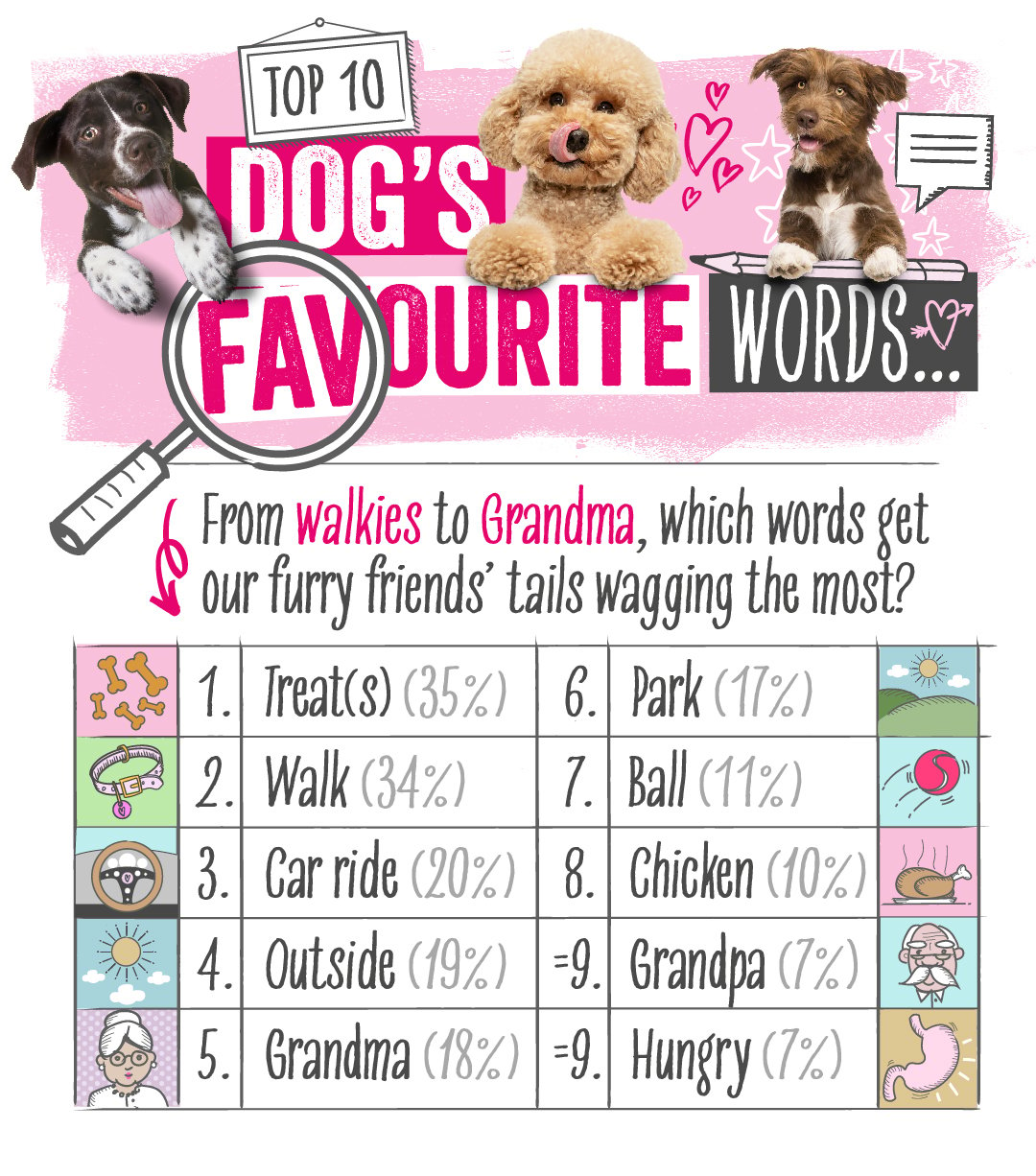Whether it’s a trip outside to the park or a piece of chicken as a treat, it’s no secret that there are a number of words that’ll get our dogs’ heads tilting, mouths opening, and tails wagging.
But which words do our four-legged friends like to hear the most?
We’ve analysed over 200 of the most-viewed TikTok videos1 made in response to the recent dog’s favourite words trend that took the internet by storm, to reveal which words featured the most frequently…
Grandma and grandpa take the crown as your pooches favourite family members

Perhaps unsurprisingly, treat(s) takes the top spot as our pooches’ favourite word, having featured in 35% of all the videos analysed, followed closely by walk or walkies in second place (34%).
Whilst we’re sure many humans can relate to the love of a treat or two, when it comes to our dogs, it’s important to make sure that what we’re feeding them is dog-friendly and given in moderation, so that they stay fit and healthy.
Whether it’s the feeling of the wind in their ears or their innate love of adventure, despite some of our furry friends associating the car with a trip to the vets, car ride made it into the top three favourite words, appearing in one in five (20%) videos.
If there’s one thing that all pet lovers can agree on, it’s that our pets are part of the family. But, when it comes to our dog’s favourite family members, the popular TikTok trend has put an end to the debate, as grandma takes fifth place (18%) in the list, and grandpa joint ninth (7%), beating the likes of mum and dad, which unfortunately didn’t make it into the top 10.
Does this mean my pets can understand what I’m saying?
It’s clear to see from this trend that dogs will respond to certain cues, but it’s not as straightforward as them understanding what we’re saying and what it means.
Catrin George, animal wellbeing specialist at Animal Friends Pet Insurance, expands: “There are a number of factors that come into play when talking about a dog’s recognition and understanding, with many debating the extent of their abilities.
“One explanation could be that they have associated the word with a particular action over a period of time, or, it could be that they’re responding to the tone and pitch in which the word was spoken, as well as the speaker’s body language whilst saying it.
“The most important thing is that each dog is different, and ultimately, owners should be encouraged to find their own way of connecting and communicating with their pet in a positive way.”
What your dog’s responses could be telling you
When trying to communicate with us, our furry friends will often try different signals until they feel understood. Some of the ways that they will try to engage, include:
Head tilt
An undeniably cute reaction, if your dog responds to your chatter with a head tilt, it can be an indication that there is an interest in what you’re saying to them. As explained by a professional trainer at petMD, dogs will instinctively move their heads from side to side when concentrating on sounds, for example, their owner’s voice, which can indicate that they’re interested in what’s being said or trying to understand an unfamiliar command or trick.
Catrin expands: “This is where word association can play out in real time. For example, if everytime you say walk to your pet in a certain tone or pitch, whilst also carrying out an action such as walking towards the door or picking up their lead, your dog will be able to recognise this, and choose to respond with a head tilt, as their way of confirming what’s about to happen.”
Open mouth grin
This will often occur as a result of human interaction and a dog’s ability to know that smiling is a common sign of happiness in their owner. Similar to what’s known as laughter contagion - when a person smiles at their dog, for example, when repeating words they know their pooch enjoys, the dog will respond with an open mouth grin, somewhat resembling a ‘smile’.
Catrin explains: “It’s important to note here that this doesn’t necessarily mean that your dog will be smiling at the specific words that were said (although that could be possible), instead, they have learnt what response will create a positive reaction from their owner, and will be responding to make them happy.”
Tail wagging
Put simply, when a dog wags its tail, it means they’re reacting to a particular scenario and attempting to show you how they feel. To understand what their response could be telling you, as explained by petMD, you need to observe the position of their tail and the speed of the wag.
Catrin shares what to look out for: “A happy wagging tail tends to be positioned slightly upright, and will move at a moderate speed from side to side, getting quicker the more excited they become. Whereas, if they’re feeling curious about what you’re saying, their tail might be held straight out with a slight wagging movement.”
So, now you know what words are most likely to get your dogs excited. We even put it to the test with the Animal Friends Pet Insurance pooches, which you can watch now over on our TikTok.
If you’re thinking about getting a dog, we have lots of resources and advice to help you on the journey; visit: https://www.animalfriends.co.uk/dog/dog-advice/
Methodology
1We pulled a list of 208 of the most-viewed TikTok videos (accurate as of 23.04.2024) using the key phrase ‘dog’s favourite words’ and analysed each video to create a list of words that featured most frequently.
